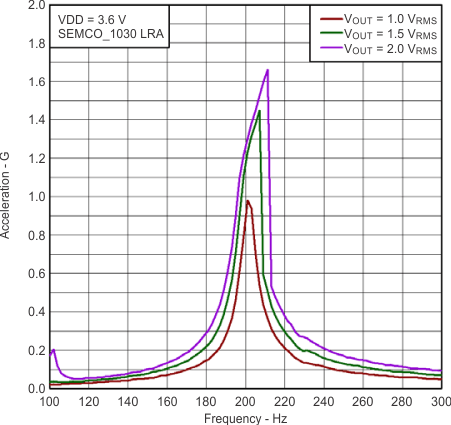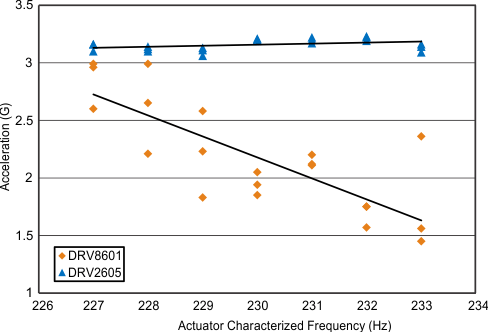SLOA188A October 2013 – November 2021 DRV2603 , DRV2604 , DRV2605 , DRV2605L-Q1 , DRV2624 , DRV2625
3 Auto-Resonance Vibration Strength
Linear resonant actuators have a very narrow resonant frequency, as shown in Figure 3-1. The narrow resonance is a result of the resonance behavior of the spring and mass inside the LRA. An LRA will have a resonance at one frequency with a steep drop on either side.
 Figure 3-1 Resonant
Frequency of Linear Resonant Actuators
Figure 3-1 Resonant
Frequency of Linear Resonant ActuatorsThe graph in Figure 3-1 shows acceleration versus frequency using three different driver output voltages. As the voltage increases, likewise the acceleration, the resonance frequency shifts making it impossible to predetermine the resonance frequency of an LRA.
Auto-resonance will ensure vibration performance across all actuators, no matter the resonance frequency. TI’s auto-resonance algorithm dynamically determines the resonance frequency as the actuator is vibrating.
Figure 3-2 depicts the lab results of 21 actuators driven by the DRV2605 (blue dots) and the DRV8601 without auto-resonance (orange dots). The 21 actuators have data sheet specified resonant frequencies of 230Hz, but are separated into 7 frequency groups based on their actual resonant frequency at maximum acceleration. The orange dots are driven at 230Hz and the blue dots are driven by the auto-resonance tracking algorithm. From the graph, the DRV2605 shows consistent acceleration across actuators, while the orange has mixed results due to the constant drive frequency (230 Hz). The graph shows that auto-resonance provides consistent acceleration across actuators. DRV2625 has same characterization but can act over a broader range of frequencies (45Hz-300Hz)
 Figure 3-2 Acceleration Performance of the DRV2605 versus DRV8601
Figure 3-2 Acceleration Performance of the DRV2605 versus DRV8601